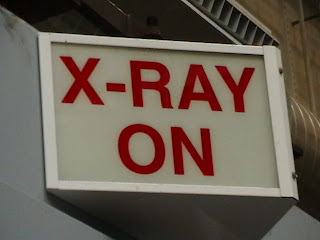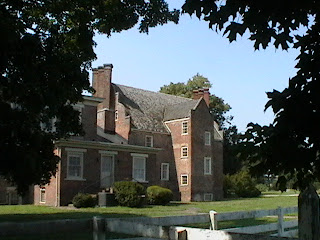Today (July 2nd), I spent time visiting the houses of two more presidents - Thomas Jefferson and James Monroe. We visited Monticello first, and were given a very nice tour of the house. It was just as beautiful as I remembered it being, and just as full of cool things. A really interesting tidbit that I picked up was that there had been more discoveries made about Jefferson's interior design since the last time I had been there! In the dining room and the sitting room off of it, the Thomas Jefferson Monticello Foundation had originally painted the room blue, to match a design that they found on the fire place. However, paint chip analysis recently revealed that the room was not sky blue, but instead a "chrome yellow", a color that would have been thirty times more expensive than blue in Jefferson's time. They had repainted the room, and I think it looks wonderful! It was very bright and cheery, and made it feel like an even larger space.
 |
| Monticello was all ready for the Fourth of July! |
A few more Jefferson facts that I learned during my time there:
-Jefferson had pet mockingbirds, which he fed from his hand, and absolutely adored
-He could read in seven different languages
-He owned over 300 different maps, globes, and atlases
-If you stand on the East porch, and look towards the east, there is nothing taller than you are until Portugal
-During the construction of UVA, Jefferson had a wonderful view of the construction of the college from his East Porch, and you can still see the rotunda from there today!
At the end of the tour, our tour guide asked us if anyone knew what Jefferson had wanted to have written on his grave. I was the only one who knew!
 |
| Thomas Jefferson - Author of the Declaration of Independence, of the Statute of Virginia for Religious Freedom, and the founding of the University of Virginia. |
After our official tour, we walked around the outside some, visited his grave, saw the gardens and Mulberry Row, and toured the cellars. Outside of the cellars, there was a kid's station set up, and we got to try writing out part of the Declaration with a quill and ink! It was harder than I expected it to be, especially because you had to dip the pen in ink every few seconds. Still though, it was really neat to try it!
 |
| Beautiful Monticello! |
 |
| The gardens behind the house |
 |
| A stroll down Mulberry Row |
After visiting Mr. Jefferson's house, we traveled to Highland, also referred to as Ashlawn, to visit the Monroe residence. It was a big contrast. If anyone wants to visit these houses I would definitely recommend it, but I would advise visiting Monroe's house first, and then Jefferson's. Monroe had a very humble house, especially when compared to Jefferson's, and the tour is much more relaxed.

Inside of the house we were able to tour a few of the main rooms, such as the dining room, the drawing room, and some of the bedrooms and a parlor. There were three things about my visit to Highland that really stuck out to me, and they are not really related at all. First, we were all shocked to learn about Mrs. Monroe. James Monroe's wife was 5'2" (that's my height), but weighed only 80 pounds! We saw some of her dresses, and they were almost child-sized! Second, we learned about a very interesting family connection. Eliza Madison (Jame's daughter) attended a boarding school in Paris, where she became friends with a girl by the name of Hortense. Hortense's mom's name was Josephine, and after Hortense's father died, her mom married Napoleon Bonaparte. Hortense ended up marrying Napoleon's brother, Louis Bonaparte, and she became the Queen of Holland. The last thing that I really enjoyed were the animals. There were supposedly peacocks, but I didn't find any. However, we did find the sheep!
























































